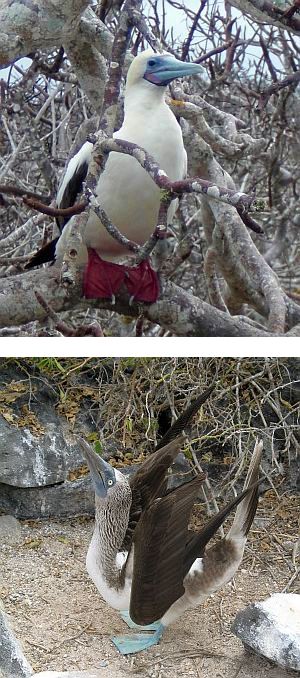 Dr. Seuss was talking about fish but when I received these two photos from Deb Acklin this title immediately came to mind.
Dr. Seuss was talking about fish but when I received these two photos from Deb Acklin this title immediately came to mind.
Here are two unusual characters you’re never going to see at home. Deb saw them at the Galapagos Islands last month.
Meet the red-footed booby and the blue-footed booby.
No lie! These birds are called boobies from the Spanish word for dunce because they’re very clumsy on land. Their fancy feet aren’t made for walking, they’re made for impressing the opposite sex. Same idea as stiletto heels.
The two species have different nesting habits (red-footed boobies nest in trees, blue-footed on the ground) but they have similar courtship displays in which their feet play a part.
During courtship the males of both species point their bills and tails at the sky, raise their wings and, most importantly, display their feet. The blue-footed booby even does a dance in which he lifts and stamps each foot to show it off.
All this is to impress the ladies who are flying by in hopes one of them will stop and get to know him. If she does, the pair will put their feet to another use – incubating the eggs. Boobies don’t have a brood patch so they use their feet, just like their relatives the northern gannets.
Interestingly, female blue-footed boobies have bluer feet than the males. Click on the picture to see how blue they can get!
The boobies’ courtship efforts are successful at the Galapagos but their nesting success depends on the food supply – fish – and the food supply is governed by ocean temperature. During an El Niño event, the ocean heats up and the fish go elsewhere. This spells trouble for the boobies. Their chicks starve, with as much as 70% nest failure for red-footed boobies who lay only one egg per year. Even if the chicks survive, during an El Niño they grow so slowly that it takes a year to mature.
Sadly, red-footed boobies face another threat. Unlike blue-footeds whose largest breeding population is on the Galapagos, red-footed boobies breed on many Pacific islands. In some places they are in decline because the islanders eat them.
Fortunately the Galapagos has protection programs to keep the birds safe. I hope to go there some day and see these fancy feet for myself.
(photos taken at the Galapagos Islands by Deborah Acklin)
I highly recommend a trip to Galapagos. It is truly remarkable.